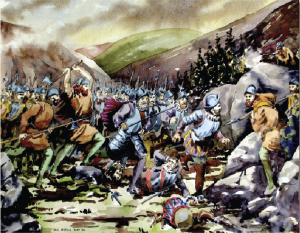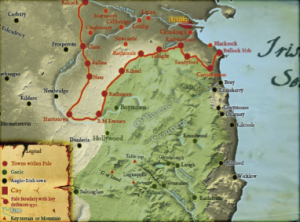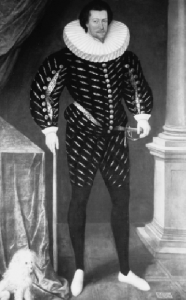From a spark to a firebrand: Feagh Mac Hugh O’Byrne
Published in Early Modern History (1500–1700), Features, Issue 5 (September/October 2013), Volume 21
Above: Feagh Mac Hugh O’Byrne’s crushing victory over Lord Arthur Grey de Wilton at Glenmalure in 1580 marked the zenith of his military achievements. (Val Byrne)
Chris Lawlor traces the rise of the O’Byrne clan, and particularly the Gabhal Raghnaill sept, during the long sixteenth century, outlining the resistance of Feagh Mac Hugh O’Byrne and some of his forebears to the Crown.
Feagh Mac Hugh O’Byrne is synonymous with County Wicklow, and was one of the first leaders in that county to oppose English rule. What was his contribution to Irish affairs during the sixteenth century, in particular during the Baltinglass rebellion and the Nine Years War? The latter was primarily a revolt by Ulster chieftains under Hugh O’Neill, earl of Tyrone, but there was also a Wicklow theatre, where Feagh Mac Hugh’s resilience and tenacity in the face of adversity demonstrated why he had earned the sobriquet ‘Firebrand of the Wicklow Mountains’. By Feagh’s final year (1597), Lord Deputy Russell had identified him as ‘the cheife rebel of Lynster’, indicating the progress made by the Gabhal Raghnaill sept of the O’Byrne clan as the sixteenth century progressed.
Early Kildare dominance

From Glenmalure the clan had access to Glendalough and the Glen of Imaal, providing channels towards both the Pale and lowland Leinster, with an emergency escape route via the plateau atop Table Mountain to the north-west. (Tomás Ó Brogáin)
In the early sixteenth century Leinster was identified with the governorship of the Kildares. Garret Mór ruled with an iron hand, especially after his victory over the rebellious Burke and his allies at Knockdoe on 19 August 1504. The influence of the Kildares spread, and in 1508 the ‘Duties upon Irishmen’ in their rental, listing Gaelic Irish leaders from whom they received tributes, included all the major chiefs of Leinster, with the O’Byrnes prominent among them. Garret Mór, however, died in September 1513, and his successor, Garret Óg, did not wield the same control. He suffered some embarrassing defeats at the hands of the native Irish, and the success of the O’Byrnes’ raid on Dublin Castle in 1533 underlined both the decline of the earls of Kildare and the advancement of the Wicklow clan. In 1534 the two factions actually joined forces during the revolt of Silken Thomas, but this was ultimately crushed and Thaddeus, the chief of the O’Byrnes, submitted to Henry VIII in 1535. In 1536 he promised to be a faithful subject, not to maintain rebels, and to pay monies to the king in return for possession of his lands and the protection of the lord deputy. The Henrican Reformation represented a sea change in political as well as in religious relationships on the island of Ireland, however, and the issues involved in the Kildare revolt indicated that there were large numbers of Irish (and Anglo-Normans) whose Catholicism could be invoked to undermine loyalties to the English monarchy.
The mid-sixteenth century witnessed a game of cat and mouse being played out between the English authorities and the Gaelic chiefs. At one stage Thaddeus O’Byrne even requested that his territory be shired. As Sir John Davies recalled, ‘the Byrnes of the mountains, in the thirty-fourth of Henry VIII [1542] desired that their county might be made shire ground and called the county of Wicklow’. The clan, however, rejected this proposal, removed Thaddeus from the leadership and elected a new chief, Shane Mac Redmond, who opposed the scheme. The mid-sixteenth century witnessed continuing sporadic clashes between the O’Byrnes and the authorities. In 1548, for example, Shane’s son, Hugh Mac Shane O’Byrne, threatened the Boystown area, occupying it with 60 kernes for three days. In 1566 Hugh Mac Shane raided Ballymore Eustace, which lay on the very boundary of the Pale, and exacted black rents there. These actions pointed to Hugh’s belligerent intentions and increased the rising power of the Gabhal Raghnaill sept, which emerged as the leading branch of the O’Byrne clan during this time. Hugh’s Gabhal Raghnaill was a formidable force, and they regularly embarked on raids and expeditions against contiguous English settlements. Edmund Spenser’s View of the state of Ireland confirmed the improved fortunes of the clan under Hugh’s leadership.
Feagh

Lord Deputy Sir William Russell—returned to Wicklow in autumn 1596 to put Feagh and his army to flight. Feagh was subsequently discovered in a cave in Glenmalure and killed on 7 May 1597. (Woburn Abbey)
It was Hugh’s son, Feagh, however, who truly figured among the foremost Gaelic leaders of his age. Feagh was born c. 1544. As a young man, he was involved in Sir Edmund Butler’s escape from Dublin Castle in 1569, and was implicated in the murder of Robert Browne in Wexford in 1572. Crucially, he grew to maturity at a time when his clan’s fortunes were waxing. Elizabeth I was crowned in 1558, however, and the Elizabethan administration was the principal agency of Anglicisation in Ireland. Such a policy was opposed to the Gaelic way of life practised and the social control wielded by the O’Byrnes and other clans. The stage was thus set for further conflict.
Feagh proved to be a thorn in the side of the Dublin administration throughout the 1560s and 1570s. In 1563 Feagh and his father captured two captains, Henry Davells and George Harvey, probably with the intention of holding them for ransom. The prisoners were eventually released and the abductors pardoned, but Feagh’s lengthy campaign of resistance had begun. Kinship bonds and close family loyalties were a significant feature of Gaelic Ireland, and in 1572 Feagh joined his brother-in-law, Rory Óg O’More of Laois, in attacking the Pale. Later in that decade, on 21 September 1578, Feagh submitted to Lord Justice Drury at Christ Church Cathedral. The game of cat and mouse with the authorities continued; in all, Feagh was pardoned seven times for treachery against the Crown. By the beginning of 1580 Rory Óg had been killed (but not before he had burned Naas in retaliation for the massacre of Mullaghmast in 1577) and Feagh and his followers had been pacific for a little over a year. This situation changed dramatically with the outbreak of the Desmond rebellion in Munster, an event that received papal support.
Battle of Glenmalure
![The English army returning triumphant from battle, carrying the severed heads of the defeated Irish. The one on the extreme right, held by the hair, is reputedly Feagh’s sister, Margaret Maol O’Byrne, wife of Rory Óg O’More, both killed in early 1580. (John Derrick’s Image of Irelande [1581])](https://www.historyireland.com/wp-content/uploads/2013/09/111-300x173.png)
The English army returning triumphant from battle, carrying the severed heads of the defeated Irish. The one on the extreme right, held by the hair, is reputedly Feagh’s sister, Margaret Maol O’Byrne, wife of Rory Óg O’More, both killed in early 1580. (John Derrick’s Image of Irelande [1581])
Glenmalure was one of the heaviest defeats ever suffered by Crown forces in Ireland. It caused panic within the Pale and on the streets of the capital, where a follow-up attack by Feagh’s forces was expected almost hourly once the calamitous news had come through. Feagh, however, did not possess the military strength for such a risky undertaking, so he remained in the mountains awaiting developments. Victory was sweet but short-lived. The rebellion ultimately failed, but highland Wicklow was still firmly in O’Byrne’s possession. It is true that Sir William Stanley burnt Feagh’s settlement at Ballinacor in April 1581, but its remote nature made it difficult to hold and Feagh and his followers soon reoccupied the area. Throughout most of the 1580s and ’90s, the highland Wicklow region was referred to as ‘O’Byrnes’ Country’ or ‘Feagh Mac Hugh’s Country’, and the chief’s presence so close to Dublin was both an embarrassment and a challenge to the authorities. The suitability of the Ballinacor site for defence meant that the O’Byrnes had no need to construct a stone fortification within its fastnesses, and a wooden fort was deemed sufficient for their needs. From Glenmalure the clan had access to Glendalough and the Glen of Imaal, providing channels towards both the Pale and lowland Leinster, with an emergency escape route via the plateau atop Table Mountain to the north-west.
Escape of Red Hugh O’Donnell
The 1590s witnessed an escalation of hostilities. Red Hugh O’Donnell and Art O’Neill escaped from Dublin Castle in 1591. They headed towards Glenmalure. After great hardship, resulting in O’Neill’s death in the Wicklow Mountains, O’Donnell reached O’Byrnes’ country. It is perhaps simplistic to assume—and there is no documentary evidence to support the premise—that local mountain-dwellers aided the escape, as any loyalties owed by Wicklow peasants to a prince from Donegal were, at the very least, probably quite tentative. Nonetheless, the event created a bond of sorts between Feagh and Red Hugh, possibly forged through the ideas of Gaelic identity and Counter-Reformation Catholicism.
In May 1593 Red Hugh O’Donnell, with the help of Archbishop Magauran, instigated a confederation; later that year Hugh Maguire instigated his military campaign. O’Donnell joined him in 1594 and, crucially, Hugh O’Neill did likewise in 1595. Also in that year, Feagh was declared a traitor and a large reward was offered for his capture or his head. In 1596 Feagh formally allied himself with O’Neill and took the field on 9 September, gambling on a successful Spanish landing. The shipwreck of the ‘second armada’ off La Coruña on 13 October, however, sealed Feagh’s fate. Following news of the ships’ destruction, Lord Deputy Sir William Russell returned to Wicklow to put Feagh and his army to flight. The old chief was discovered in a cave in Glenmalure and killed by a Sergeant Milburne (under the command of Captain Thomas Lee) on 7 May 1597. Hostilities continued briefly under the leadership of Feagh’s son and successor, Phelim Mac Feagh O’Byrne, but by the dawn of the new century this revolt had also been crushed and the Wicklow region was at last ripe for plantation.
Conclusion
From the late 1570s onwards Feagh Mac Hugh O’Byrne was the foremost Gaelic chief in Leinster, ably succeeding his brother-in-law Rory Óg O’More in that role after the latter’s death. Feagh’s participation in the Baltinglass revolt, and his resounding victory at Glenmalure in 1580, raised his profile considerably and catapulted him to national prominence. Feagh’s use of Gaelic identity, his adherence to Catholicism, his record on the field of battle, his complex relations with other Gaelic chiefs and with Baltinglass all point to diplomatic adroitness, military skill, political adaptability and a keen instinct for survival. Feagh’s involvement in the Nine Years War and the longevity of his military operations in highland Wicklow drained the resources of the Crown, which needed to maintain a constant military presence to protect areas of adjacent lowland Leinster and the Pale from attack. Feagh’s death was a severe blow to O’Neill’s cause, and in 1598, when the earl was most in need of the O’Byrnes to keep the forces of the Pale occupied, it deprived O’Neill of support and the use of highland Wicklow as a diversionary theatre. In the final analysis, Feagh’s military operations were a diversion within a larger conflict and his standing was not on a par with that of Tyrone; nevertheless, as the earl’s powerful Leinster ally, his support aided the rise of Hugh O’Neill and his attempt to defeat English forces—an attempt that almost succeeded. HI
Chris Lawlor teaches history in Meánscoil Iognáid Rís, Naas, Co. Kildare.
Read More : Edmund Spenser on Feagh
‘Dreadfully slaughtered by the Irish party’
‘The place where Fiach Mac Aodha was’
IRISH CHIEFS’ PRIZE IN HISTORY 2014
Further reading
D. Byrne-Rothwell, The Byrnes and the O’Byrnes, vol. i. A new insight upon Irish history (Isle of Colonsay, 2010).
County Wicklow Heritage Project, The last county: the emergence of Wicklow as a county 1606–1845 (Wicklow, 1993; reprinted 2006).
C. Maginn, ‘Civilizing’ Gaelic Leinster: the extension of Tudor rule in the O’Byrne and O’Toole lordships (Dublin, 2005).
C. O’Brien (ed.), Feagh McHugh O’Byrne: the Wicklow Firebrand (Rathdrum, 1998).
















